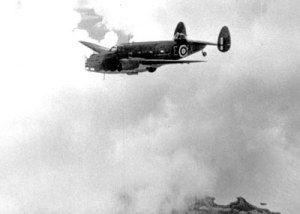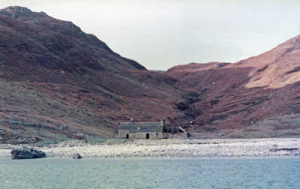Hudson III plane crash at Mulhagery
Hudson Bomber crashes in Southern Pairc during the war.
In 1942 a Lockheed Hudson bomber crashed in Southern Pairc close to Mulhagery. The bomber flew into the rocky hillside at Fiar Chreag while flying in over the water in foggy weather. Had the plane managed to climb another 10 feet they would have cleared the top of the hill. Fiar Chreag rises very steeply from close to the sea and would have come up very quickly if they were flying blind in fog.
A Hudson bomber on Atlantic patrol
The RAF knew that the plane must have come down over land but despite spending over three weeks searching from the air they failed to find the crashed bomber. At that time there were Walrus Seaplanes based at the airfield in Stornoway and these flew over the area but without any success.
Nearly four weeks after the crash the crew of the regular passenger flight from Glasgow to Stornoway spotted something glinting in the sun and reported this when they reached Stornoway. The passenger service plane at that time was a Dominee bi-plane which carried only 10 passengers.
Following the sighting a land based search was undertaken but still failed to find the plane on the first day as they had been directed to the hills above Valamus 10 miles away. The following day when they found out that they were searching in the wrong area they moved to the Fiar Chreag close to Mulhagary. There seems to have been some confusion between the shepherds house at Mulhagery and the house at Valamus. The search team was led by Duncan Macrae, Head Gamekeeper at Eishken Estate.
Mulhagery- ruins of Sheep Farm in Southern Pairc
They found the remains of the bomber scattered over a wide area and totally disintegrated. The three crew were all dead and one was found some distance from the plane with a coat pulled over his head. He must have either been thrown clear or managed to crawl out of the wreckage. The bodies when removed and taken down to the beach at Mulhagery but the weather was unfavourable with strong winds preventing a boat from coming in to collect the bodies.
After 4 weeks when they had not been collected Lady Jessie Thornycroft, the owner of the Eishken Estate, complained to the RAF as the bodies were still lying under canvas on the shore. They made arrangements for a team to go over land into what is a very inaccessible area but in fact they managed to make a landing from a boat and the bodies were taken to Stornoway.
The Lockheed Hudson bomber was on lease-lend from the US and was flown by Coastal Command and engaged in anti-submarine defence. Some of the remains of the bomber are still on the hillside and the engines are still clearly visible.
Narrated by Dan Macleod, Lemreway and written by Donnie Morrison, Chairman, Pairc Historical Society.
12th July 2000
Further extract from our archives :-
15/31 31.07.42 HUDSON III FH375 V/500 Sqn Stornoway
The Squadron was getting ready to move to St Eval, and all aircraft were serviceable except for FH375 which had its radar U/S. The radar was repaired but it required an air-test to finish the job. The weather at Stornoway was bad with low cloud and all aircraft were grounded. But for some reason the Hudson was allowed to take off. Its crew were F/O Rigby as pilot, P/O Hancock on radar and Sgt Rixon who was the radar technician.
When the Hudson failed to return a sea search was started, followed, when the weather improved by an air search. Nothing was found and the search was wound down. Then on the 25th August, the pilot of a Scottish Airways Rapide reported seeing wreckage near Kebock Head. But this reported location was too far north and again nothing was found. The Squadron had to move and leave the search in the hands of 15 Gp Coastal Command.
The search was now made on foot, by means of landing the men on suitable beaches. On the 29th August, the party landed at Mulhagery, and within 90 minutes they had returned to the boat with the bodies of the crew of the Hudson. Because of rough water it was not possible to put the bodies aboard the pinnace. So it was not until the 9th September that the bodies were landed at Stornoway.
There are still large remains of the Hudson on Fiar Chreag at map reference 14/365074. It lies on private land, and the permission of Eishken Estate should be obtained to visit the crash site.
RAF records give the date of death of all three crew members as 31.07.42, but the head stone of F/O Rigby is dated 01.08.42.
Crew:
F/O John Derek Brearley Rigby (age 22) buried – Sandwick Cemetery
P/O Frank Richard Hancock buried – Sandwick Cemetery
Sgt Bernard Frederick Charles Rixon (age 37) buried – Hoddesdon, Herts
Photos from Dave Earl whjo visited teh site in May 2000 Posted by cepaircadmin | 8 comments






